Zen requires that we maintain our sense of awe and wonder, that pure curiosity about the things we see and experience, that search for meaning and significance that is so apparent in the works of ancient man. We cannot allow technology to dull our awe and jade our curiosity about the meaning of life. We cannot look upon our ancient past as if it were our gestational period, a pre-sentient phase of existence. We need to be aware always of the spirit of inquiry. If we had brought scientific integrity to the images we saw in Egyptian tombs and to the question of why the blue lotus was used to describe the Buddha’s eyes, we might have learned that not only did this flower symbolize long life, good health, and even sexual pleasure, it actually provided these benefits.
The countenance of the Buddha is like the clear full moon,
Or again, like a thousand suns releasing their splendour.
His eyes are pure, as large and as broad as a blue lotus.
His teeth are white, even and close, as snowy as white jade.
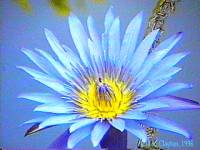 Dated fossil remains of the Blue Lotus, Nymphea caerulea savigny, tell us that it has undergone little change in 160 million years. At the first rays of morning sun it opens revealing intricate lancet-shaped petals then, at noon, it closes to a bud and sinks into the water not to reappear until the following day. Its beauty and medicinal properties have been immortalized in art and myth for millennia. Something may strike us odd about these lines of scripture. Anyone who has been to China or India is familiar with lotus flowers: they are white or pink or cream or rose colored …but they are not blue.
Dated fossil remains of the Blue Lotus, Nymphea caerulea savigny, tell us that it has undergone little change in 160 million years. At the first rays of morning sun it opens revealing intricate lancet-shaped petals then, at noon, it closes to a bud and sinks into the water not to reappear until the following day. Its beauty and medicinal properties have been immortalized in art and myth for millennia. Something may strike us odd about these lines of scripture. Anyone who has been to China or India is familiar with lotus flowers: they are white or pink or cream or rose colored …but they are not blue.
We’re all prepared to visualize the Buddha’s blue eyes. He was an Aryan, of European descent, a nobleman in a societal caste system that did not ‘officially’ intermarry with native populations. The rigidity of the system can be seen even in further generations. Nearly a thousand years later, Bodhidharma, another Aryan descendant, was called The Blue Eyed Demon by the Chinese.
Also, in recent years we’ve witnessed the startling discoveries of three thousand year-old blond and red haired Caucasian mummies in the Takla Makan area of western China. We know beyond question that Aryans were indeed present in the Orient long before the Christian era; but Nymphea caerulea savigny, the blue lotus, was not. The plant had disappeared from the entire region during the Ice Age over ten thousand years ago.
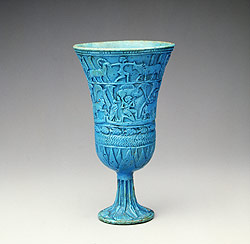 In this Egyptian cup from approximately 800 BC, we see the blue lotus motif common in Ancient Egyptian art. Above the distinctly triangular pointed petals are relief scenes showing the plant's marshy habitat. What was it that made the blue lotus so significant, so revered in memory or legend that scripture selected it to describe the color of the Buddha’s eyes? Many objects could have served as blue referents. Even the sky would have sufficed. Yet a virtually unknown flower was chosen.
In this Egyptian cup from approximately 800 BC, we see the blue lotus motif common in Ancient Egyptian art. Above the distinctly triangular pointed petals are relief scenes showing the plant's marshy habitat. What was it that made the blue lotus so significant, so revered in memory or legend that scripture selected it to describe the color of the Buddha’s eyes? Many objects could have served as blue referents. Even the sky would have sufficed. Yet a virtually unknown flower was chosen.
We Buddhists are left wondering why centuries have passed without anyone wondering just what qualities the blue lotus possessed that it should have been selected to represent such an important feature: the wide open eyes of the Awakened One.
Scholars have long noted the peculiar and ubiquitous presence of the blue lotus in Egyptian art. And everywhere that it appears in tomb or temple it is a potent and benevolent symbol: a face is gently pressed against the flower to inhale its pollen or to savor its scent; a goblet of wine receives an infusion of crushed lotus flowers, the better somehow to enjoy the drink; bouquets are offered to pharaohs just as pharaohs offer them to other gods, reverently and with the certain knowledge that these flowers, rather than jewels, are fit offerings to divinity; a newborn Sun god emerges from a huge blue lotus which floats on the surface of the Nun, the pre-primordial Waters of infinite space and infinite time from which the Universe was born.
Scholars considered the lotus and concluded that as the Easter lily symbolized the Resurrection, and Poinsettia the Nativity, and a variety of plants represented sacred persons, qualities,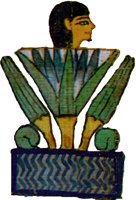 Egyptian hieroglyph depicting rebirth of the spirit from the center of a blue lotus. or events, the blue lotus merely symbolized well-being and long life to the ancient Egyptians, possibly even the act of creation itself. And that was all there was to it.
Egyptian hieroglyph depicting rebirth of the spirit from the center of a blue lotus. or events, the blue lotus merely symbolized well-being and long life to the ancient Egyptians, possibly even the act of creation itself. And that was all there was to it.
And the Buddha’s eyes? Scholars looked at modern Indians and found the idea absurd. Blue was dismissed as a misreading of the word “clear” which simply indicated that his eyes were not bloodshot or jaundiced or, more abstractly, that they were capable of great, celestial discernment. Often the scriptural line was considered another fanciful exaggeration of the Thirty-Two Marks of a Superman. Usually, however, racial and ethnic prejudices were invoked, either to validate the traditional image of an Asian Buddha or to support Teutonic requirements for an acceptable deity, one that bore a swastika on its chest and was the founder of the Aryan Path. Peacemakers challenged all disputes, finding the Buddha’s eye color absolutely irrelevant. Nobody wondered about the blue lotus itself. The flower’s intrinsic nature was ignored.
 Looking into the Universe we see nothing but other galaxies in a vast void of space. The ancients would not have been able to discriminate stars from galaxies since they all look like points of light to the naked eye, yet myths and ancient art, many involving the blue lotus, tell us they had a knowledge of infinite space and infinite time - a knowledge that modern cosmologists are still grappling to understand. But there was indeed a cryptic message in that choice of blue referents, and it was only recently that anyone tried to decipher it.
Looking into the Universe we see nothing but other galaxies in a vast void of space. The ancients would not have been able to discriminate stars from galaxies since they all look like points of light to the naked eye, yet myths and ancient art, many involving the blue lotus, tell us they had a knowledge of infinite space and infinite time - a knowledge that modern cosmologists are still grappling to understand. But there was indeed a cryptic message in that choice of blue referents, and it was only recently that anyone tried to decipher it.
Scientists at the University of Manchester, England, asked the question that we should have been asking all along: What was there about the blue lotus that made it so noteworthy?
They tested living samples of the flower and then compared these results to flowers that had been removed from ancient Egyptian sarcophagi. The results indicated that the flower’s properties were identical: the living blue lotus was the same flower that the ancients had revered; and the chemical properties of that flower were those of such popular remedies as ginseng and gingo biloba and that famous blue pill, Viagra.
We know today that the blue lotus contains nuciferine, a hypnotic compound known to relax smooth muscle tissue and to have vasodilating, hypotensive, and anti-arrhythmic properties. When the plants’ crushed seeds or concentrates are mixed with wine, a powerful sexual stimulant is produced.  Nuciferine, a constituent of the Blue Lotus, is now known to have vasodilaing, hypotensive, and anti-arrhythmic properties.
Nuciferine, a constituent of the Blue Lotus, is now known to have vasodilaing, hypotensive, and anti-arrhythmic properties.
More than just the “feel good” drug of the New Kingdom, the blue lotus would have been the drug of choice for treating migraine headaches, Alzheimer’s disease, heart conditions, and a variety of sexual maladies that were also alleviated by improved blood flow. Especially considering the diseases and parasitic infestations that afflicted all our ancestors, and are still with us today, this versatile plant would truly have been a godsend. Yet by inserting our foolish prejudice into the interpretation of scripture and art we deprived ourselves of centuries of benefit.
 A painted carving found in the corridor of Tutankhamun's tomb shows the head of a young boy in a representation of the infant sun god, Nefertem, arising from the blue lotus which, itself, grew out of the primordial ocean. Prejudice blinds and stultifies. It was never a question of lacking the resources for investigation. We wouldn't have had to use mass spectroscopy or any other sophisticated equipment to discover the properties of the blue lotus. We could simply have gathered the flowers, sniffed, ingested, or concentrated their essence and, following the instructions illustrated on temple walls, mixed the concentrate with wine. The first person to do this would likely have solved the mystery.
A painted carving found in the corridor of Tutankhamun's tomb shows the head of a young boy in a representation of the infant sun god, Nefertem, arising from the blue lotus which, itself, grew out of the primordial ocean. Prejudice blinds and stultifies. It was never a question of lacking the resources for investigation. We wouldn't have had to use mass spectroscopy or any other sophisticated equipment to discover the properties of the blue lotus. We could simply have gathered the flowers, sniffed, ingested, or concentrated their essence and, following the instructions illustrated on temple walls, mixed the concentrate with wine. The first person to do this would likely have solved the mystery.
We now realize that the blue lotus possessed such extraordinary abilities that its qualities became legendary; and word of its cultural significance spread across vast continents, lending importance to other lotus species that did not possess the blue lotus' chemical constituents..
The art and folklore of India and the rest of Asia do not speak of blue lotuses, but they do speak of creation myths unusually similar to those of ancient Egypt. For example, in ancient India, the Hiranya Garbha Gayatri was chanted in devotion to the Heavenly Lotus, the egg or womb of gold, from which Brahma the infinite source of time, space, and causation emerges:
"Om Premathmaanaya Vidmahe
Hiranya Garbhaaya Dheemahi
hannah Sathya Prachodayaath"
In China and other parts of East Asia, where we find native pink and white lotus varieties in much Buddhist artwork; we find that just like the Egyptian's infant sun god, a Buddha, a Bodhisattva, or another celestial deity sits or stands upon an open flower as if the flower itself were giving birth to a great Cosmic Principle.
Ancient creation myths do, however, speak of the blue lotus, and it is these myths that were evidently known to Aryans long before Cleopatra or Alexander, in the distant lands of India where the flower did not grow.
 Guan Yin (Kannon) gazing upon a patch of pink lotus blossoms. The pink lotus is ubiquitous in Asian art and usually depicted with a celestial saviour, an archetypal symbol of the infinite and eternal. Illustration courtesy of Xin Dé Shakya, of Hong Fa temple, Shen Zhen, China. We know that there was trade between Europe and China in antiquity. Chinese artifacts have been found deep in the ruins of Troy. And, as Claude Björk, an Archeologist at Stockholm University, asserts, the presence in Europe of ancient materials, “especially of obsidian, jade, bronze and silk” indicates that there was indeed contact between West and East as long ago as 2000 BC. The blonde mummies of Urumchi in the Takla Makan also show that Europeans were traveling to ancient China during this period and that they carried European textiles, wheat and other commodities with them. Knowledge of the blue lotus’ reputation could easily have spread globally for centuries before the Silk Road was to become the world’s first major conduit for commerce between East and West.
Guan Yin (Kannon) gazing upon a patch of pink lotus blossoms. The pink lotus is ubiquitous in Asian art and usually depicted with a celestial saviour, an archetypal symbol of the infinite and eternal. Illustration courtesy of Xin Dé Shakya, of Hong Fa temple, Shen Zhen, China. We know that there was trade between Europe and China in antiquity. Chinese artifacts have been found deep in the ruins of Troy. And, as Claude Björk, an Archeologist at Stockholm University, asserts, the presence in Europe of ancient materials, “especially of obsidian, jade, bronze and silk” indicates that there was indeed contact between West and East as long ago as 2000 BC. The blonde mummies of Urumchi in the Takla Makan also show that Europeans were traveling to ancient China during this period and that they carried European textiles, wheat and other commodities with them. Knowledge of the blue lotus’ reputation could easily have spread globally for centuries before the Silk Road was to become the world’s first major conduit for commerce between East and West.
The irony is that the knowledge of the plant’s salutary qualities was there ‘right in front of our eyes’ for centuries; yet we ignored it. Most of us embraced modern pharmacology and laughed condescendingly at Folk Medicine’s herbal remedies, remedies which constituted our entire pharmacopoeia less than a century ago. Surely, we thought, anything we needed we could invent. For centuries there was a need for Viagra and other blood-vessel dilators, but that need went unfulfilled. Only now, when we have finally raised those Bamboo and Iron Curtains that had divided whole continents for more than half a century, have we discovered the evidence of international commerce that existed five thousand years ago. We also begin to understand that medical knowledge was more advanced than we ever imagined.
Though we do not usually trust the intuitions of our distant ancestors, there are times when their insights astonish us. It is, for example, remarkable to see how modern physicists’ theories of the origins of the universe are reflected in the symbols of creation myths passed down through generations for thousands of years. Many physicists have pondered the shape of the early universe. Mathematical models of possible energy-density and space-time structures in many ways remind us of the manner in which a flower opens its petals.
 Physicists model the topology of the universe in intriguing ways. A universe with negative curvature, as represented by the temporal energy-flux hyperboloid on the left represents an open universe; one in which space expands forever in time. A universe with zero, or positive curvature, on the other hand, is represented by a sphere and depicts a closed universe: one in which space and time are finite. Scientists now know that we live in an open universe, one in which time and space expand forever. Buddhist theology has always favored the infinite, flower-shaped, model; for our Buddha Amitabha, has a second name Amitayus - the former meaning infinite light, and the latter, infinite time. (Illustrations courtesy of The Official String Theory Website) There are countless examples of our ancestors’ insights: skeletal remains from 5000 BC demonstrate knowledge of brain surgery and use of antibiotics as long ago as 4500 BC; birch bark was also used to preserve food during this time because of its anti-microbial properties and, by 3300 BC, European travelers were chewing it and carrying it along with other antibiotics in medical kits. There is also evidence from the discovery of the Tyrolean Iceman who lived during this time that acupuncture may have originated in Europe and may have been carried to Asia by travelers. Genetic Engineering may have begun with Neolithic farmers who successfully modified and cultivated maize. Even the computer has ancient origins. The “Antikythera mechanism” was found in a shipwreck dated to 100 BC: it was made from epicyclic and differential gears, and included dials and inscriptions for operating instructions.
Physicists model the topology of the universe in intriguing ways. A universe with negative curvature, as represented by the temporal energy-flux hyperboloid on the left represents an open universe; one in which space expands forever in time. A universe with zero, or positive curvature, on the other hand, is represented by a sphere and depicts a closed universe: one in which space and time are finite. Scientists now know that we live in an open universe, one in which time and space expand forever. Buddhist theology has always favored the infinite, flower-shaped, model; for our Buddha Amitabha, has a second name Amitayus - the former meaning infinite light, and the latter, infinite time. (Illustrations courtesy of The Official String Theory Website) There are countless examples of our ancestors’ insights: skeletal remains from 5000 BC demonstrate knowledge of brain surgery and use of antibiotics as long ago as 4500 BC; birch bark was also used to preserve food during this time because of its anti-microbial properties and, by 3300 BC, European travelers were chewing it and carrying it along with other antibiotics in medical kits. There is also evidence from the discovery of the Tyrolean Iceman who lived during this time that acupuncture may have originated in Europe and may have been carried to Asia by travelers. Genetic Engineering may have begun with Neolithic farmers who successfully modified and cultivated maize. Even the computer has ancient origins. The “Antikythera mechanism” was found in a shipwreck dated to 100 BC: it was made from epicyclic and differential gears, and included dials and inscriptions for operating instructions.
Often we fail to look at our ancestors with sufficient awe and gratitude for the fortitude and wisdom that brought us to the place we are today. Usually, we prefer to imagine that we are superior to our ancestors. We disguise our condemnation of religious or cultural practices that are alien to our own by calling them remnants of a barbaric past. We assume that the cruelties of the Roman Coliseum or the Spanish Inquisition are representative of a primitive stage from which we have greatly evolved. We boast about the technological sophistication of the 20th century: nuclear energy, moon visits, the Internet; but we blind ourselves to the false pride and religious prejudice that have also, in that same century, brought us the Holocaust, the Rape of Nanjing, the killing fields of Cambodia, and other atrocities of such scale and variety that no human heart can bear to describe or enumerate them.
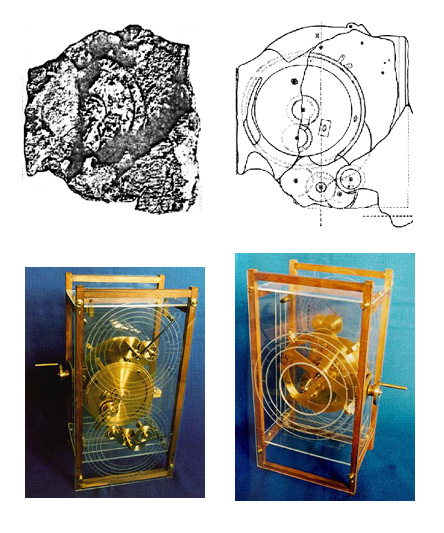 The Antikythera Mechanism is the oldest known computer. It was discovered in the wreckage of a ship from the first century BC off Antikythera, near Crete, and was used for navigation. Made of bronze, it utilized many principals of mathematics and physics that, until this discovery, were attributed to the last few hundred years of the second millennium. Illustrations: top left: one of several artifacts of the Antikythera mechanism found in the wreckage; top right: schematic of original apparatus after x-ray analysis of the artifact; bottom left and right: two views of a modern reproduction of the navigational device, fabricated by John Gleave of the United Kingdom. The unit stands approximately 12 inches high.
The Antikythera Mechanism is the oldest known computer. It was discovered in the wreckage of a ship from the first century BC off Antikythera, near Crete, and was used for navigation. Made of bronze, it utilized many principals of mathematics and physics that, until this discovery, were attributed to the last few hundred years of the second millennium. Illustrations: top left: one of several artifacts of the Antikythera mechanism found in the wreckage; top right: schematic of original apparatus after x-ray analysis of the artifact; bottom left and right: two views of a modern reproduction of the navigational device, fabricated by John Gleave of the United Kingdom. The unit stands approximately 12 inches high.
Today we suffer needlessly at the hands of technology, not because of technology, but because of our relationship to it. Just as we ignored the actual nature of the lotus and the uses to which it was put, substituting facile opinion for serious investigation, we worship technological innovations using new devices without considering the purpose and quality of their use. That we are able to accomplish a task becomes a sufficient reason to perform it, and we value technology for technology’s sake alone. We have computers, cell phones, beepers, televisions with hundreds of channels but what about the quality of those communications? Our email is littered with junk advertisements, idiotic ‘chain’ letters, and pornography. Our phones ring incessantly with solicitations. Our bank account dwindles as we purchase a vast array of gadgets that promise to make our lives better. But they don’t fulfill that promise. We are neither better nor happier human beings for all the jingles, beeps and chirps. We are stressed by our fast pace of life, tired from lack of sleep, and angry because we are denied the opportunity for “peace and quiet” - the solitude we all require.
Our attitude toward life has become trivialized. Recognizable images of human life are eliminated from art; and along with this omission, human values dissapear. We produce prettier computers but no Davids or Sistine ceilings. As our poetry increases in abstract prolixity, it declines in simple emotional expression.
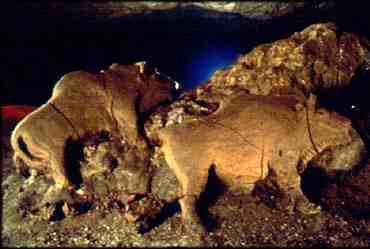 15,000 years ago these bison were sculpted from clay in the cave Le Tuc d'Audoubert, France. Yet we still recognize the Human Spirit when we encounter it in the remnants of our past. When we read the works of Plato or see ancient Greek statues we are touched; and when we see the artistic depth and beauty of the Lascaux cave art from civilizations that existed thousands of years before the Ice Age, we are more than touched. We are astonished.
15,000 years ago these bison were sculpted from clay in the cave Le Tuc d'Audoubert, France. Yet we still recognize the Human Spirit when we encounter it in the remnants of our past. When we read the works of Plato or see ancient Greek statues we are touched; and when we see the artistic depth and beauty of the Lascaux cave art from civilizations that existed thousands of years before the Ice Age, we are more than touched. We are astonished.
Twenty-five hundred years ago the Buddha taught that what is Real is inherently unchanging and is therefore outside of time. The art portrayed by the ancients of Lascaux seems to radiate that timeless quality about which the Buddha preached. Could we, today, improve upon these ancient artists’ works?
All that makes us human continues; yet, while we are the technological superiors of the ancients, we are in no way their superiors in poetry, drama, art, music, and philosophy, or in any spiritual expression. And we are not their superiors in decency and integrity.
 Art from our ancestors 31,000 years ago is well preserved in the caves of Lascaux, France. That these ancients lived in an advanced culture is clear not only from the stories told by the clear depictions of animals, but by the fact that organized community effort was needed to penetrate the deep dark caverns. Zen requires that we maintain our sense of awe and wonder, that pure curiosity about the things we see and experience, that search for meaning and significance that is so apparent in the works of ancient man. We cannot allow technology to dull our awe and jade our curiosity about the meaning of life. We cannot look upon our ancient past as if it were our gestational period, a pre-sentient phase of existence. We need to be aware always of the spirit of inquiry. If we had brought scientific integrity to the images we saw in Egyptian tombs and to the question of why the blue lotus was used to describe the Buddha’s eyes, we might have learned that not only did this flower symbolize long life, good health, and even sexual pleasure, it actually provided these benefits.
Art from our ancestors 31,000 years ago is well preserved in the caves of Lascaux, France. That these ancients lived in an advanced culture is clear not only from the stories told by the clear depictions of animals, but by the fact that organized community effort was needed to penetrate the deep dark caverns. Zen requires that we maintain our sense of awe and wonder, that pure curiosity about the things we see and experience, that search for meaning and significance that is so apparent in the works of ancient man. We cannot allow technology to dull our awe and jade our curiosity about the meaning of life. We cannot look upon our ancient past as if it were our gestational period, a pre-sentient phase of existence. We need to be aware always of the spirit of inquiry. If we had brought scientific integrity to the images we saw in Egyptian tombs and to the question of why the blue lotus was used to describe the Buddha’s eyes, we might have learned that not only did this flower symbolize long life, good health, and even sexual pleasure, it actually provided these benefits.
Enter the Path! There spring the healing streams
Quenching all thirsts! There bloom the immortal flowers
Carpeting all the way with Joy! There throng
Swiftest and sweetest hours.
-- The Buddha, from Sir Edwin Arnold's The Light of Asia
We don't know which “immortal flowers” the Buddha was referring to, but if it was the blue lotus, we have allowed our modern arrogance to obscure an important clue.
